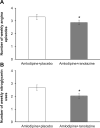Safety and Efficacy of Ranolazine for the Treatment of Chronic Angina Pectoris
- PMID: 24574825
- PMCID: PMC3932785
- DOI: 10.4137/CMT.S7824
Safety and Efficacy of Ranolazine for the Treatment of Chronic Angina Pectoris
Abstract
Coronary heart disease is a global malady and it is the leading cause of death in the United States. Chronic stable angina is the most common manifestation of coronary heart disease and it results from the imbalance between myocardial oxygen supply and demand due to reduction in coronary blood flow. Therefore, in addition to lifestyle changes, commonly used pharmaceutical treatments for angina (nitrates, β-blockers, Ca2+ channel blockers) are aimed at increasing blood flow or decreasing O2 demand. However, patients may continue to experience symptoms of angina. Ranolazine is a relatively new drug with anti-anginal and anti-arrhythmic effects. Its anti-anginal mechanism is not clearly understood but the general consensus is that ranolazine brings about its anti-anginal effects by inhibiting the late Na+ current and the subsequent intracellular Ca2+ accumulation. Recent studies suggest other effects of ranolazine that may explain its anti-anginal and anti-arrhythmic effects. Nonetheless, clinical trials have proven the efficacy of ranolazine in treating chronic angina. It has been shown to be ineffective, however, in treating acute coronary syndrome patients. Ranolazine is a safe drug with minimal side effects. It is metabolized mainly in the liver and cleared by the kidney. Therefore, caution must be taken in patients with impaired hepatic or renal function. Due to its efficacy and safety, ranolazine was approved for the treatment of chronic angina by the Food and Drug Administration (FDA) in 2006.
Keywords: chronic angina; late Na+ current; mitochondria; ranolazine.
Conflict of interest statement
Figures





Similar articles
-
New Anti-Anginal Drugs: Ranolazine.Cardiovasc Hematol Agents Med Chem. 2015;13(1):14-20. doi: 10.2174/1871525713666141219112841. Cardiovasc Hematol Agents Med Chem. 2015. PMID: 25544118 Review.
-
Ranolazine (Ranexa) for chronic stable angina.Issues Emerg Health Technol. 2007 Jun;(99):1-6. Issues Emerg Health Technol. 2007. PMID: 17595750
-
Anti-ischemic and pleiotropic effects of ranolazine in chronic coronary syndromes.Am J Med Sci. 2024 Mar;367(3):155-159. doi: 10.1016/j.amjms.2023.12.001. Epub 2023 Dec 9. Am J Med Sci. 2024. PMID: 38072070 Review.
-
Ranolazine: effects on ischemic heart.Recent Pat Cardiovasc Drug Discov. 2013 Dec;8(3):197-203. doi: 10.2174/15748901113089990023. Recent Pat Cardiovasc Drug Discov. 2013. PMID: 23961914 Review.
-
Emerging clinical role of ranolazine in the management of angina.Ther Clin Risk Manag. 2010 Oct 21;6:517-30. doi: 10.2147/TCRM.S4468. Ther Clin Risk Manag. 2010. PMID: 21063462 Free PMC article.
Cited by
-
CUPID: a protocol of a randomised controlled trial to identify characteristics of similar Chinese patent medicines.BMJ Open. 2014 Nov 27;4(11):e006753. doi: 10.1136/bmjopen-2014-006753. BMJ Open. 2014. PMID: 25431225 Free PMC article. Clinical Trial.
-
Open-label pilot study of ranolazine for cramps in amyotrophic lateral sclerosis.Muscle Nerve. 2022 Jul;66(1):71-75. doi: 10.1002/mus.27560. Epub 2022 May 11. Muscle Nerve. 2022. PMID: 35466411 Free PMC article.
-
Possible Interaction between Dabigatran and Ranolazine in Patients with Renal Failure.Medicina (Kaunas). 2019 Dec 29;56(1):13. doi: 10.3390/medicina56010013. Medicina (Kaunas). 2019. PMID: 31905748 Free PMC article.
-
Ranolazine: An Old Drug with Emerging Potential; Lessons from Pre-Clinical and Clinical Investigations for Possible Repositioning.Pharmaceuticals (Basel). 2021 Dec 25;15(1):31. doi: 10.3390/ph15010031. Pharmaceuticals (Basel). 2021. PMID: 35056088 Free PMC article. Review.
-
Chronic Heart Failure and Coronary Artery Disease: Pharmacological Treatment and Cardiac Rehabilitation.Medicina (Kaunas). 2025 Jan 24;61(2):211. doi: 10.3390/medicina61020211. Medicina (Kaunas). 2025. PMID: 40005328 Free PMC article. Review.
References
-
- Roger VL, Go AS, Lloyd-Jones DM, et al. Executive summary: heart disease and stroke statistics—2012 update: a report from the American Heart Association. Circulation. 2012 Jan 3;125(1):188–97. - PubMed
-
- Fox K, Garcia MA, Ardissino D, et al. Guidelines on the management of stable angina pectoris: executive summary: The Task Force on the Management of Stable Angina Pectoris of the European Society of Cardiology. Eur Heart J. 2006 Jun;27(11):1341–81. - PubMed
-
- Holubkov R, Laskey WK, Haviland A, et al. Angina 1 year after percutaneous coronary intervention: a report from the NHLBI Dynamic Registry. Am Heart J. 2002 Nov;144(5):826–33. - PubMed
-
- Hueb W, Soares PR, Gersh BJ, et al. The medicine, angioplasty, or surgery study (MASS-II): a randomized, controlled clinical trial of three therapeutic strategies for multivessel coronary artery disease: one-year results. J Am Coll Cardiol. 2004 May 19;43(10):1743–51. - PubMed
-
- Gilead S. Ranexa® (Ranolazine Extended-Release Tablets) [Accessed Jul 27, 2012]; http://www.Gilead.Com/Pdf/Ranexa_Pi.Pdf.Pdf.
Grants and funding
LinkOut - more resources
Full Text Sources
Other Literature Sources
Miscellaneous
